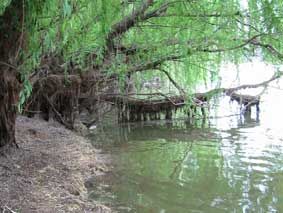Major Group: Insecta
Order: Trichoptera
Family: Calamoceratidae
Genus: Anisocentropus
This family is represented in Australia by a single genus, Anisocentropus Mclachlan. |
Descriptive Features: pronotum with long rounded projections at the anterolateral corners
mesonotum moderately sclerotised and usually with a dark inverted "V" of stronger sclerotization
metanotum with 3 pairs of very small sclerites each with long setae
metasternum without setae
hindlegs very long, at 2X length of the forelegs
abdomen flattened, with divided gills and with a strong lateral fringe of setae
Total length: 8 - 12 mm
Case: Flat, made of only 2 pieces of leaf material. |

|
Anisocentropus latifascia |
|
|

|
Anisocentropus |
|
Taxonomic Checklist: Species
Anisocentropus banghaasi Ulmer (larva unknown)
Anisocentropus bicoloratus Martynov (larva unknown)
Anisocentropus corvinus Neboiss (larva unknown)
Anisocentropus eungellus Neboiss (larva unknown)
Anisocentropus kirramus Neboiss (larva unknown)
Anisocentropus latifascia (Walker)
Anisocentropus muricatus Neboiss (larva unknown)
Anisocentropus semiflavus Banks (larva unknown)
Anisocentropus torulus Neboiss (larva unknown)
Anisocentropus valgus Neboiss (larva unknown) |
|
Distribution: NT, NSW, Vic, N WA, Qld, SA, Tas, ACT
Sensitivity Rating: SIGNAL grade 7
Functional Feeding Group: shredders |

|
Murray River, Yarrawonga Vic |
|
|
Ecology: Instream habitat: Calamoceratidae species are found in both fast flowing riffle zones and slow flow areas of cool streams and in backwater areas of large, warm lowland rivers or lakes. Larvae are found in areas where detritus accumulates. Pupae are commonly found attached to rocks but some may be found in leaf litter.
Feeding ecology: Larvae are detritivores feeding on coarse plant detritus. First instar larvae move between the epidermal layers of leaves to feed on the internal tissue.
Habit: Larvae construct a dorso-ventrally flattened case, from two pieces of leaves, that resembles a bag, giving rise to the common name of ‘sleeping bag caddis’.
Life history: Females lay their egg in masses attached to the surface of leaves within litter packs. Eggs hatch after three to ten days. Larvae generally undergo five instars. Northern Australian species emerge almost all year round. More southern species may have reduced emergence over winter. |
| |
Information Sources: St Clair 1997, Dean et al 2004, Neboiss 2003, Nolan & Pearson 1992, Sloane & Norris 2002
Key to Species: none |
|
|
|